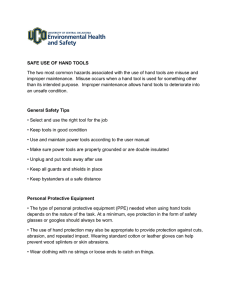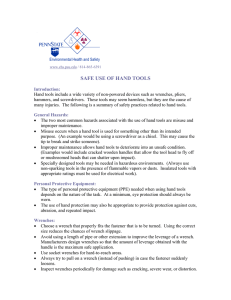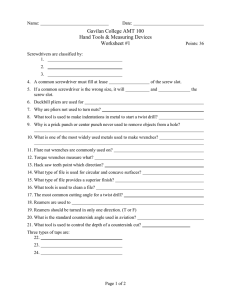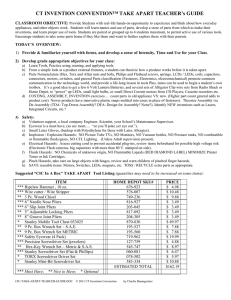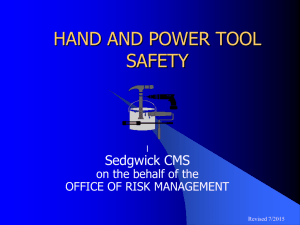1 Tool Proper Uses Abuse/Misuse Nail Hammers Nail hammers are
advertisement
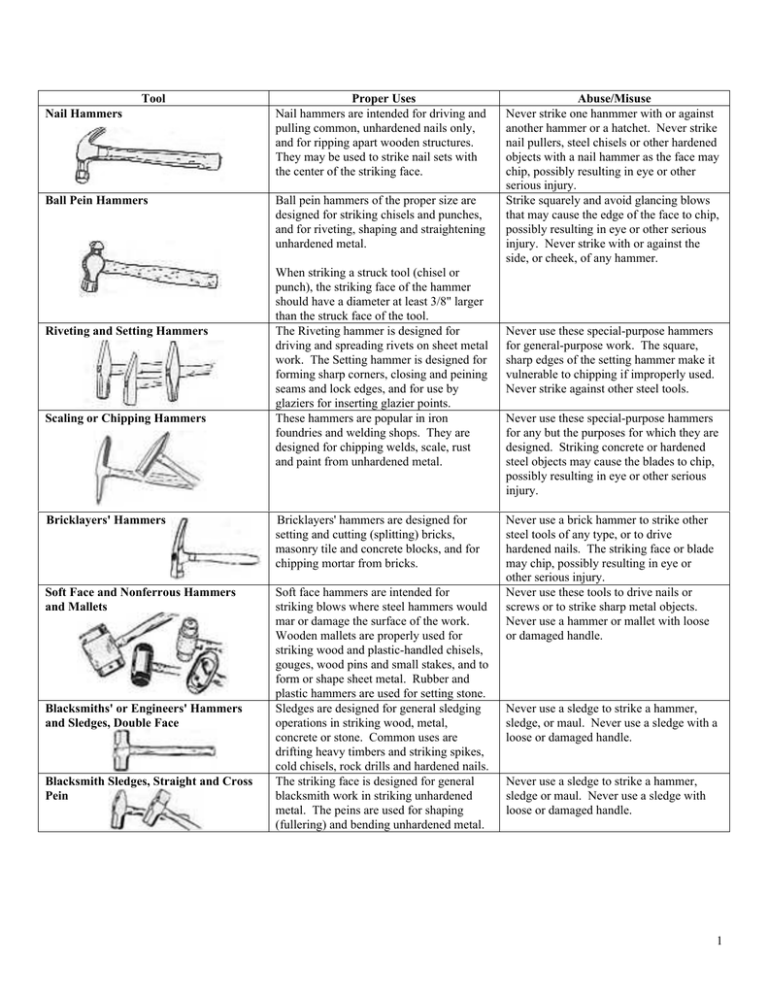
Tool Nail Hammers Ball Pein Hammers Riveting and Setting Hammers Scaling or Chipping Hammers Proper Uses Nail hammers are intended for driving and pulling common, unhardened nails only, and for ripping apart wooden structures. They may be used to strike nail sets with the center of the striking face. Ball pein hammers of the proper size are designed for striking chisels and punches, and for riveting, shaping and straightening unhardened metal. When striking a struck tool (chisel or punch), the striking face of the hammer should have a diameter at least 3/8" larger than the struck face of the tool. The Riveting hammer is designed for driving and spreading rivets on sheet metal work. The Setting hammer is designed for forming sharp corners, closing and peining seams and lock edges, and for use by glaziers for inserting glazier points. These hammers are popular in iron foundries and welding shops. They are designed for chipping welds, scale, rust and paint from unhardened metal. Bricklayers' Hammers Bricklayers' hammers are designed for setting and cutting (splitting) bricks, masonry tile and concrete blocks, and for chipping mortar from bricks. Soft Face and Nonferrous Hammers and Mallets Soft face hammers are intended for striking blows where steel hammers would mar or damage the surface of the work. Wooden mallets are properly used for striking wood and plastic-handled chisels, gouges, wood pins and small stakes, and to form or shape sheet metal. Rubber and plastic hammers are used for setting stone. Sledges are designed for general sledging operations in striking wood, metal, concrete or stone. Common uses are drifting heavy timbers and striking spikes, cold chisels, rock drills and hardened nails. The striking face is designed for general blacksmith work in striking unhardened metal. The peins are used for shaping (fullering) and bending unhardened metal. Blacksmiths' or Engineers' Hammers and Sledges, Double Face Blacksmith Sledges, Straight and Cross Pein Abuse/Misuse Never strike one hanmmer with or against another hammer or a hatchet. Never strike nail pullers, steel chisels or other hardened objects with a nail hammer as the face may chip, possibly resulting in eye or other serious injury. Strike squarely and avoid glancing blows that may cause the edge of the face to chip, possibly resulting in eye or other serious injury. Never strike with or against the side, or cheek, of any hammer. Never use these special-purpose hammers for general-purpose work. The square, sharp edges of the setting hammer make it vulnerable to chipping if improperly used. Never strike against other steel tools. Never use these special-purpose hammers for any but the purposes for which they are designed. Striking concrete or hardened steel objects may cause the blades to chip, possibly resulting in eye or other serious injury. Never use a brick hammer to strike other steel tools of any type, or to drive hardened nails. The striking face or blade may chip, possibly resulting in eye or other serious injury. Never use these tools to drive nails or screws or to strike sharp metal objects. Never use a hammer or mallet with loose or damaged handle. Never use a sledge to strike a hammer, sledge, or maul. Never use a sledge with a loose or damaged handle. Never use a sledge to strike a hammer, sledge or maul. Never use a sledge with loose or damaged handle. 1 Tool Axes and Hatchets Cold Chisels Blacksmiths' Punches Hand Punches Drift Pins Proper Uses The double bit axe is usually used to fell, trim or prune trees and to split and cut wood. It is also used for notching and shaping logs and timbers. The single bit axe, in addition to the above uses, is used to drive wood stakes with the striking face. Hatchets are used for cutting, splitting, trimming and hewing, and driving unhardened nails and stakes with the striking face. Cold chisels have a cutting edge at one end for cutting, shaping and removing metal softer than the cutting edge itself such as cast iron, wrought iron, steel, bronze, copper, etc. and a struck face on the opposite end. Blacksmiths' round punches are designed for drifting holes, aligning and driving pins. Blacksmiths' backing out punches are designed for backing out bolts, rivets and pins. Punches are designed to mark metal and other materials softer than the point end, drive and remove pin and rivets, and align holes in different sections of material. Drift pins are designed for aligning holes in metal. Ripping Bar or Wrecking Bar Bars are heavy steel tools used to lift and move heavy objects and to pry where leverage is needed. They are also used to remove nails and spikes during wrecking operations. Socket Wrenches Hand Socket wrenches are made in a wide range of sizes and capacities. All have square drives ranging from 1/4" to 1". Drive size is a measure of capacity. Since Detachable Socket wrenches provide an almost endless combination of handles, attachments and sockets, it is possible to assemble a proper tool for almost any type of service within the tool's capacity. Abuse/Misuse The cutting edges of axes and hatchets are designed for cutting wood and equally soft materials. They should never be struck against metal, stone or concrete. The striking faces of hatchets are properly hardened for driving common nails but should never be used to strike chisels, punches, rock drills or other hardened metal tools, or for striking stone or concrete. Never use an axe as a wedge or a maul. Never strike with the sides. Never use cold chisels for cutting or splitting stone or concrete. Never use a dull chisel or one with a mushroomed head. Never use a blacksmiths' cold chisel with a loose or damaged handle. Never use a punch with a mushroomed struck face or a chipped or deformed point. Never use a punch with a loose or damaged handle. Never use a punch with a mushroomed struck face or with a dull, chipped or deformed point. Never use a drift pin as a punch. Never strike a drift pin if either end is chipped or mushroomed. Never use like a striking tool or pound like a chisel. They should not be struck against metal, stone, or concrete. Do not add extensions or stand on bar for extra leverage. Do not use cracked or deformed bars. Never use a pipe extension or other form of "cheater" to increase the leverage of any wrench. Select a wrench whose opening exactly fits the nut. If possible, always pull on a wrench handle and adjust your stance to prevent a fall if something lets go. There are three types of Sockets_hand, power and impact_all different in design and hardness. Hand Sockets should never be used on power drive or impact wrenches. 2 Tool Box Wrenches Adjustable Wrenches Combination Box_Open-End Wrenches Proper Uses Box wrenches in the regular pattern are designed for general service. The HeavyDuty and Striking Face patterns are designed for the service indicated. The Electronic Hex Box patterns are designed for the lighter service encountered in electronic, carburetor and ignition work. Ratcheting Box and split box wrenches are for light duty and should not be used in heavy-duty applications. Adjustable wrenches are designed to provide a wide range of capacity in a single tool and are a convenient wrench for service and repairmen, linemen, etc. They are not intended to replace fixed opening wrenches for production or general service work. Combination Box_Open-End wrenches are designed for a wide variety of work. Their box opening adds still more to their versatility and strength. The Flare Nut pattern with its hex box opening is especially useful in air conditioning and refrigeration work where tubing terminates on flare nuts. The thinner and slimmer Electronic pattern is designed for work where access and clearance are limited. Abuse/Misuse Never use a hammer on any wrench other than a Striking Face wrench. Use a sledge type hammer. Never use an extension on the wrench handle. Do not use an adjustable wrench to free a "frozen" nut or to final tighten a nut. Never pull on a loosely adjusted wrench. Never use a hammer or extension on this wrench. Do not use the open end of these wrenches to free a "frozen" nut or final tighten a hex nut. Use the box opening. Never use an extension on the wrench handle. 3 Tool Linemen's Side Cutting Pliers Utility Pliers Long Nose pliers Diagonal Cutting Pliers Flat Nose Pliers End Cutting Pliers Slip Joint Pliers Proper Uses These are heavy-duty tools designed for the professional mechanic engaged in electrical, communications and construction work. These pliers are widely used by plumbers, electricians, auto mechanics and mechanics in the construction and industrial fields. They will grip round, square, flat and hexagonal objects and are capable of applying limited torque without damage to the work. Most Long Nose pliers are designed for electrical, telephone and electronic work involving the smaller wire gauges. They will reach into awkward places and perform work difficult with any other tool. Their usefulness, however is not limited to wire work. Diagonal cutting pliers are designed for electrical, electronic, telephone, general and automotive work involving cutting and skinning wire, cutting and removing cotter pins, nails and other fasteners. Flat Nose pliers have diverse uses in the electrical, telephone, electronic and other fields. They are extensively used in typewriter repair and assembly work. End cutting pliers are designed for cutting wire, nails, rivets, etc. close to work. These versatile tools are designed for a wide range of service involving gripping, turning and bending. Abuse/Misuse BASIC SAFETY RULES WHICH APPLY TO THE USE OF PLIERS 1. Pliers should not be used for cutting hardened wire unless specifically manufactured for this service. 2. Never expose pliers to excessive heat. This may draw the temper and ruin the tool. 3. Always cut at right angles. Never rock from side to side or bend the wire back and forth against the cutting blades. 4. Don't bend stiff wire with light pliers. Needle nose pliers can be damaged by using the tips to bend too large a wire. Use a sturdier tool. 5. Never use pliers as a hammer nor hammer on the handles. They may crack or break, or blades may be nicked by such abuse. 6. Never extend the length of handles to secure greater leverage. Use a larger pair of pliers or a bolt cutter. 7. Pliers should not be used on nuts or bolts. A wrench will do the job better and with less risk of damage to the fastener. 8. Oil pliers occasionally. A drop of oil at the hinge will lengthen tool life and assure easy operation. 9. Safety glasses should be worn when cutting wire, etc. to protect eyes from being struck by the end of the object being cut. 10.WARNING: Ordinary plastic dipped handles are designed for comfort_not electrical insulation. Tools having high dielectric insulation are available and are so identified. Do not confuse the two. 4 Tool Pipe Tools Proper Uses When using a heavy duty Pipe Wrench, maintain a gap between the back of the hook jaw and the pipe. This concentrates the pressure at the jaw teeth only and produces the maximum gripping force and aids ratcheting action. If possible, always pull rather than push on the pipe wrench handle and maintain a proper stance with feet firm to hold balance. Pipe Wrenches are designed to turn or hold pipe; never use a Pipe Wrench to bend, raise or left a pipe. Select a Pipe Wrench with sufficient capacity and leverage_never use a pipe extender or "cheater". Pipe cutter wheels that are nicked or otherwise damaged should be replaced. When removing, rapid spinning of the die threading stock is not recommended as this may damage the tool. Abuse/Misuse Do not use a Pipe Wrench as a hammer, nor strike a Pipe Wrench with a hammer. Inspect Pipe Wrenches periodically for worn or unsafe parts and replace them. Be certain to use the correct tap size in the hole. It is recommended that the hole be of such size that the thread cut by the tap will be about 75 percent as deep as the thread on the tap. Cast iron can be tapped dry but lubricant should be used with other metals. Do not permit chips to clog flutes as this will prevent tap from turning. Do not attempt to thread hardened steel as this will probably result in a chipped or otherwise damaged die. Do not thread any rod or other cylindrical object that is larger in diameter than the major diameter of the die thread. If there is not enough space to swing the single wheel pipe cutter completely around pipe, then a three or four-wheel cutter should be used. Be certain the cutting wheel is suitable to cut type of pipe material. Thin wheel is suitable for cutting ordinary steel pipe, stout wheel is made to cut cast iron. Other wheels are available for stainless steel, plastic and other materials. Screwdrivers Never use hand threading taps in power driven equipment. Never use a spiral reamer on a rotating pipe. The reamer may snag and cause serious bodily injury. Keep the screwdriver handle clean; a greasy handle is apt to cause an accident. Use a screw-holding screwdriver to get screws started in awkward, hard-to-reach areas. Screwdrivers used in the shop are best stored in a rack. This way, the proper selection of the right screwdriver can be quickly made. Don't use a screwdriver with rounded edges or tips; it will slip and cause damage to the work or yourself. Don't use pliers on the handle of a screwdriver to get extra turning power. A wrench should only be used on the square shank or bolster of a screwdriver that is especially designed for that purpose. 5 Tool Screwdrivers (Cont'd) Proper Uses Use a ratchet-type screwdriver for speed and comfort when a great number of screws are to be driven. A rounded tip should be redressed with a file; make sure the edges are straight. Use an offset screwdriver in close quarters where a conventional screwdriver cannot be used. Abuse/Misuse Don't hold the work in one hand while using the screwdriver with the other. If the screwdriver slips out of the slot (we told you to use the right size screwdriver!) you will be most likely to receive a gash on your hand. Don't use a screwdriver for prying, punching, chiseling, scoring, or scraping. Don't use a screwdriver to check a storage battery or to determine if an electrical circuit is live. Don't expose a screwdriver blade to excessive heat as it may reduce the hardness of the blade. Don't use a screwdriver near a live wire or for electrical testing. Don't use a screwdriver with a split or broken handle. Snips Use snips for cutting soft metal only. Hard, or hardened metal may damage the cutting edges of the snips. Use the right size and type of snips for the job on hand. Don't try to cut sharp curves with straight cut snips. Avoid springing the blades. This is the result of trying to cut metal that is too thick for the snips you are using, or by trying to cut heavy wire or nails. Use only hand pressure for cutting. Never hammer, or use your foot to get extra pressure on the cutting edges. If you are resorting to such a technique, you are using too small a snip—the metal is too thick for the capacity of the snip. Don't use a screwdriver for stirring paint. Never sharpen the inside ground surface of a snip. You will ruin the cutting action if you do. Never try to sharpen an aviation-type snip. You will remove the serrations and the sheet metal will slip out of the blades when you try cutting. Don't use snips as a hammer, a screwdriver or a pry bar. There are tools for such purposes—use them. Don't dump them in a drawer with other tools. Tools with cutting edges should always be treated with extra respect. Oil the pivot bolt on the snips occasionally. Sharpen the edge by grinding or filing from outside towards the inside edge. The burr that remains will be removed by slowly closing the snip after it has been sharpened. 6 Tool Snips (Continued) Proper Uses If the snips you own have locking clips, use them when the tools are not in use. Abuse/Misuse Snips should be carefully put away after use. Wipe the cutting edges with a lightly oiled rag. Wear gloves when working with snips. Keep the nut on the bolt properly adjusted at all times. Clamps Store C-clamps by clamping them in a rack, not in a drawer. Use pads with C-clamps to avoid marring the work. Discard any clamp that has a bent frame or a bent spindle. Keep all moving parts lightly oiled and clean; however, make sure there is no dirt or oil on any part that will come in contact with the work. Make sure swivel at end of the screw is turning freely before using. Avoid using extra large clamps just for the sake of their large throats; instead use deep-throat clamps. Do not use a wrench, pipe, hammer, or pliers, to gain extra tightening; a wrench should be used only on those clamps especially designed for tightening with a wrench. Never use a C-clamp for hoisting work. Special lifting clamps are made for this purpose. Never use a C-clamp for hoisting or for supporting a scaffold or platform, that may be used to carry people. Do not use C-clamps for securing a load that may be carried over a public highway; vibration may cause the clamps to loosen and the load to break loose. 7
